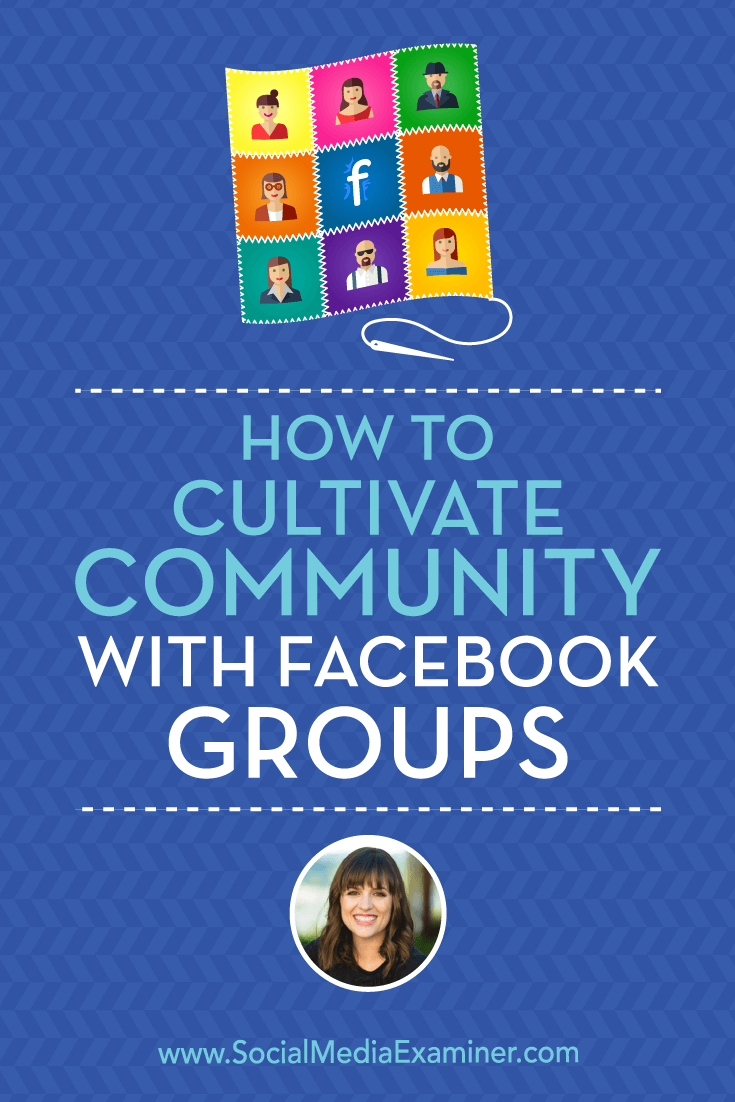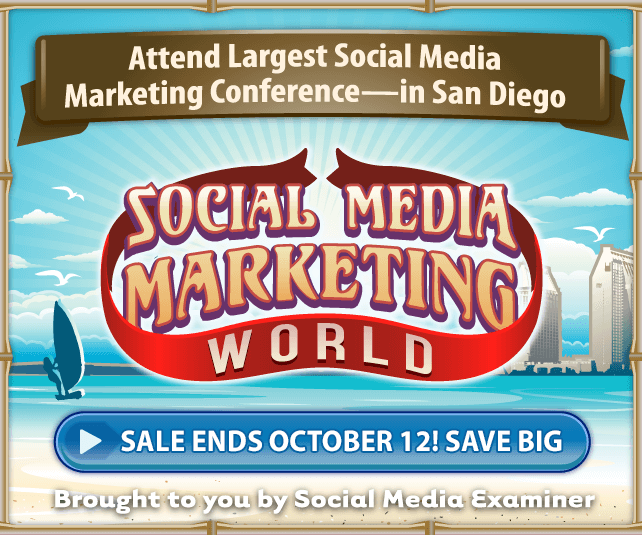Want more engagement in your Facebook group? Looking for tips on shaping your group’s culture?
To explore how to build a loyal and engaged community inside of Facebook groups, I interview Dana Malstaff.
More About This Show
The Social Media Marketing podcast is designed to help busy marketers, business owners, and creators discover what works with social media marketing.
In this episode, I interview Dana Malstaff. She’s the author of Boss Mom and host of the Boss Mom podcast. Her membership site is called Boss Mom Vault, and she’s built a thriving community in a Facebook group.
Dana explains how to lay the groundwork for a new group and attract members.
You’ll also learn how to foster group culture and engagement.
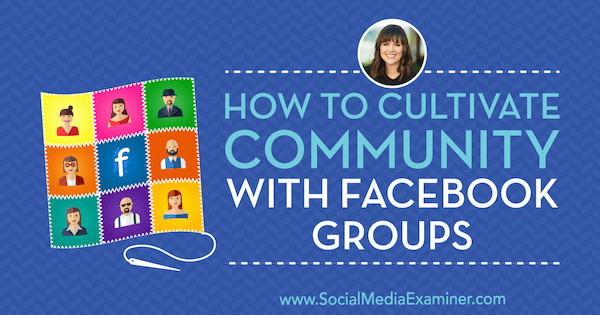
How to Cultivate Community With Facebook Groups featuring insights from Dana Malstaff on the Social Media Marketing Podcast.
Share your feedback, read the show notes, and get the links mentioned in this episode below.
Listen Now
Here are some of the things you’ll discover in this show:
Facebook Group Engagement
Dana’s Story
On New Year’s Eve, Dana rang in 2013 celebrating her last day at her full-time job. She started the new year as an entrepreneur and an expecting first-time mom. Although she was scared and had no idea how to do either, she wanted to be amazing at both. At the time, she felt isolated, living in Columbus, Ohio, surrounded by people who had full-time jobs and no kids.
After Dana’s son was born, he went to daycare while she worked, and she felt a massive amount of guilt working at home and sending her baby to school, even though that’s what she wanted to do. At one point, while she was working on her laptop in a café, the sight of a mom, daughter, and grandma made her cry.
When Dana told her husband that she wanted to move back to San Diego, California, where her parents still live, he said, “I’ll quit my job tomorrow, and we’ll sell the house.” Two months later, when her son was five months old, Dana was living in San Diego, surrounded by people who had kids and businesses. Being among people who were doing something similar to her was empowering.
At Hal Elrod’s Best Year Ever Blueprint, Dana met some people who started a mastermind group, and one of them was Azul Terronez, who helped Dana write her book, Boss Mom. The book talks about how she stopped feeling guilty about creating things while raising a child. As the book succeeded, Dana wove the Boss Mom idea into her whole brand.
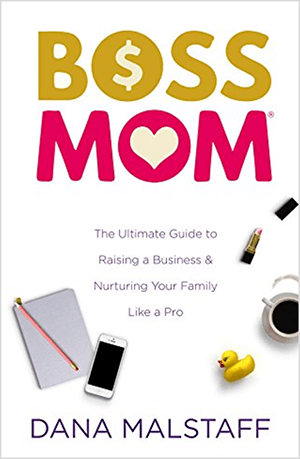
As part of that effort, Dana created the Boss Mom Facebook group, but Boss Mom is something much bigger than a Facebook group. Dana envisioned it as a movement with a culture.
In the Facebook group, Dana guides the Boss Mom culture and creates a foundation for what people expect from it, a process similar to building culture at a company. This summer, Dana launched Boss Mom meetups, so the community has an online and offline presence.
When you think about your topic as a movement with a culture, you treat it differently than many people treat their Facebook groups. With this approach, Dana’s Facebook group has grown to 33,000 members, most of whom discovered the group organically through Facebook recommendations or referrals from friends. The group adds an average of 120 members weekly.
Dana’s group isn’t only large and growing; it also has high engagement. Each month, on average, about 70% of her group members are active participants. The group has 85,000 to 89,000 interactions and about 5,000 posts each month.
Listen to the show to hear Dana and me discuss possible reasons why she found more entrepreneurs in San Diego than Columbus.
How to Build a Facebook Group
When Dana started her Facebook group, she made a common mistake: posting in the group and telling people they should hang out with her. For a while, she was the only one posting, which is a sad and depressing experience for most group owners. She hoped other people would comment and thought engaging everyone was her job alone. Otherwise, she thought no one would engage.
However, the group took a turn when Dana stopped trying to manage the group and be the host. She needed to recognize that people would naturally engage on their own.
To create a community and a culture that will grow and thrive, Dana says you need to manage from the bottom up. Instead of making rules, you set a tone and let other people find their roles. People naturally become motivators, leaders, administrators, project managers, informants, and so on. When you allow people that space, they can help you accomplish your goals for the Facebook group.
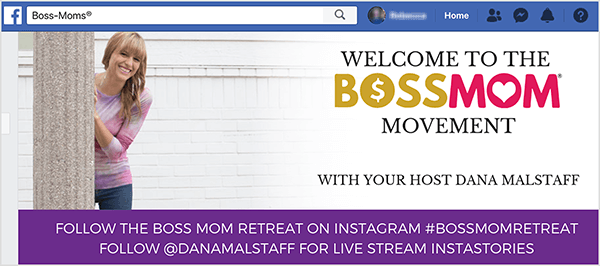
Rather than creating all the posts yourself, consider creating a challenge or call for people to post themselves. Dana might post, “Hey everybody, it’s hard to be moms and entrepreneurs. Write your own post about this struggle or post an article on this topic.” As members begin to post, the Facebook algorithm starts to think your group is interesting. Then your group can gain momentum naturally.
After your group has some members, you can also ask what types of posts they like or want to see. Dana recommends involving members in this way early on. You can ask members for their suggestions on making the group better. For example, if you write prompts every week, ask the group what kind of prompts they want to see or what would best motivate them.
To get those members, Dana built her group by spreading the word elsewhere online. In fact, she spent more time promoting her group in other spaces than she did inside the group. She sought out interviews on podcasts, created guest posts, collaborated with other group owners to offer free training, and started The Boss Mom Podcast. These activities were all opportunities to promote her group.
When Dana talked about her group, she focused on what she cared about and how she wanted to support people in her group. She chose that focus because she believes selling a movement is easier than selling a service or product. Similarly, she didn’t create a group about how to do something. Instead, she created a group around how she feels the world should be.
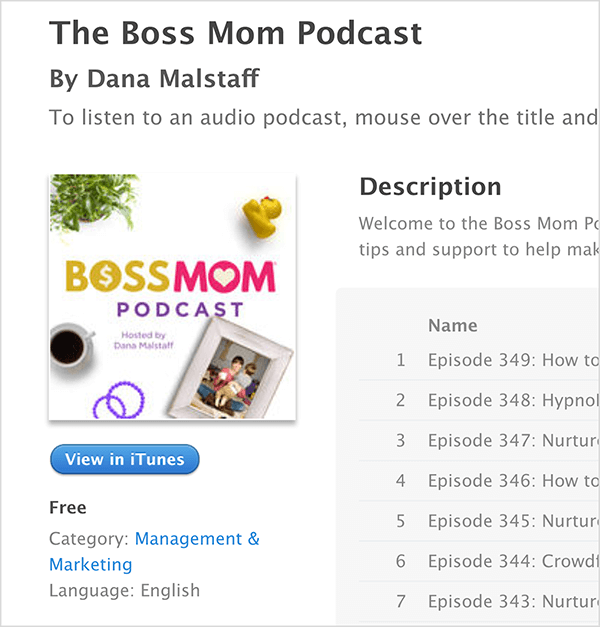
For Boss Mom, her movement manifesto centers around the feelings she had when she was new to parenthood and entrepreneurship. She’s the mom who doesn’t want to be judged for working at home while her kids go to school. She wants to be able to not shower for the day and know this doesn’t diminish her intelligence.
To promote this manifesto, Dana created phrases that other women found exciting and prompted them to hang out with women who also feel this way. To help set the tone, she also promised to fiercely protect everyone in her group. She believes this promise is important when you’re building any kind of community.
When you protect the community instead of focusing on numbers, you’ll have to remove members, but your numbers will still grow. In Dana’s group, her promise means that if someone attacks another member, they get kicked out of the group; people are kicked out of the group if they judge people for the way they potty train, the way they run their business, etc.
Listen to the show to hear Dana discuss how growing a community by protecting it is similar to providing value to potential customers.
Establishing Culture and Guidelines for Facebook Groups
To lay the groundwork for the group culture you want to foster, begin by thinking about why you want people to come to your group. People might come for tips, information about events or locations, support, or space to commiserate and complain together. In Dana’s group, people come for ideas and a sounding board, and to brainstorm together in a safe space.
When you know why people will want to come to your group, you’ll know how to set the tone. In Dana’s group, people know it’s a positive place where members support each other, the content is about 80% business and 20% parenting, and you’re encouraged to ask questions. The group can help you feel confident instead of guilty.
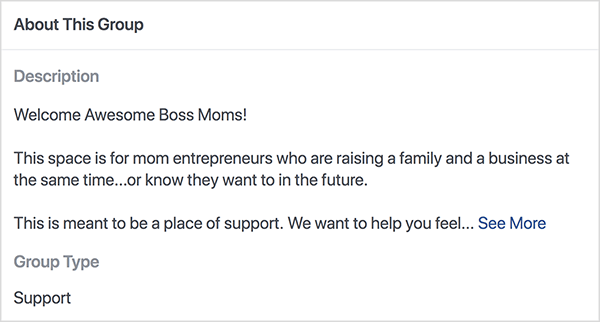
To determine why people will come to your group, look at your target audience. People don’t spend enough time on this point because they assume they know their audience. However, if you don’t map out the drivers for your group, you won’t know how to stand behind your community and beliefs when someone breaks the rules of engagement, and the community can fall apart quickly.
You can communicate the group culture and guidelines in several ways. The group description, which appears on the sidebar, is visible to anyone. Also, at the top of the group timeline, Dana pins a welcome video in which she tells members what to expect in the group and how to engage, including what they can and can’t post.
When people ask to join the group, Dana uses two of the three onboarding questions to communicate the tone. One question notes the group is a positive space where members don’t feel judged, but support each other in making business and parenting decisions. Potential members acknowledge that they agree to follow the rules and breaking them can result in being kicked out.
The second question asks whether potential members agree to post promotional content only in a promo thread and not to go live in the group. The third question asks whether potential members want free resources, and if so, to share their email address. About 50% of the people who ask to join provide their email address.
Dana finds that the questions and the welcome video she asks new members to watch (which is also a pinned announcement) help reduce the number of people who break the rules.
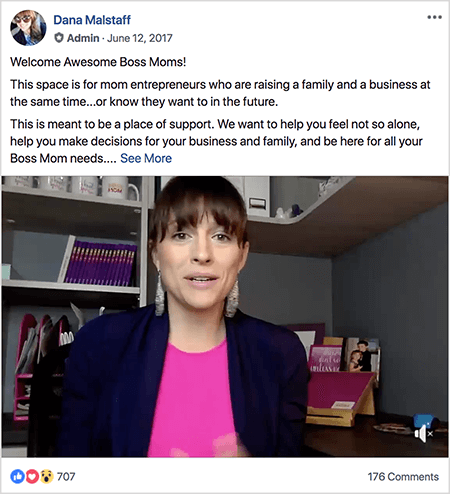
Because Dana’s group is large, she has someone on her team help manage the community instead of group members who are leaders and ambassadors. This team member accepts requests to join, removes people from the group who haven’t followed the rules, and flags questionable posts. She also pulls new members’ emails into a spreadsheet that can be imported into Ontraport.
When communicating the group’s culture and rules, Dana emphasizes what members can do as much as what they can’t. For example, members who share an email address receive a welcome email. It explains why the recipient received the email, shares what group members can expect, asks how they want to engage with Boss Mom, and offers an option to download free resources.
Dana’s welcome video also helps new members understand how to engage in the group. She explains how they can get to know everybody and mentions the stores of other members. To encourage lurkers to engage, she explains why they’ll get more value from the group by posting and participating, and challenges them to post something within the first week.
The video is also a way for Dana to share her personality and let people get to know her. She shares a little bit about herself and how she engages with the group. Every 6-9 months, she updates the video because her life is different. She wants to share who she is now and how she’s constantly changing. Also, she’s more concerned about the video being authentic than perfect.
Listen to the show to learn why Dana uses email instead of group membership questions to learn more about group members.
Facebook Group Engagement Techniques
Dana’s introduction video outlines several ways members can engage because their engagement helps the group and helps members overcome their reservations. Because members join the group to find help with their business, Dana connects her suggested engagement tactics with that goal. New members also watch what other members do to learn how to engage and what’s allowed.
Decision-Making Help: Dana loves for members to ask the group for help in making decisions. Asking questions is a good step no matter what you’re trying to do, and everyone in sales and marketing leads with questions.
In Dana’s group, she encourages members to ask one burning question they have in their business or mom life. From a business perspective, asking members to help you make decisions about what you’re creating or doing can generate buzz for whatever you want people to know about you.
Say you’re writing a book. You might post three cover images and ask members to vote on the one they like best. Similarly, members can post about choosing a podcast cover image. Or if you’re making an opt-in resource, you might ask what to make, what to name it, or what your theme should be. Someone working on their brand might ask which logo members like best.
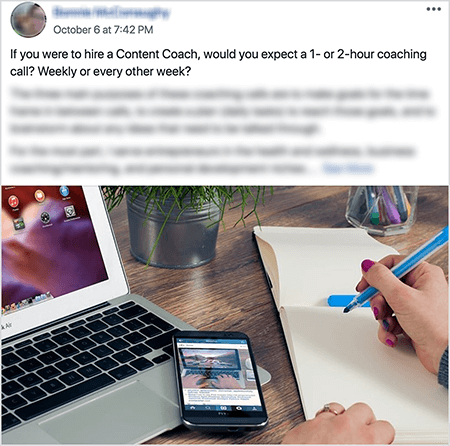
When you post these questions, the group rules prohibit including links to your book, podcast, or another item. However, from a business standpoint, you’re still creating those 7-10 touchpoints that allow other members to see what you’re doing and become familiar with you. Also, people love to engage with these questions. Everyone has an opinion.
Dana promoted the first Boss Mom retreat by asking a question about renting furniture in both her own group and other groups. She had pictures of different styles (such as 1920s, modern, and classic furniture) and asked which style people liked best. Hundreds of people responded, and she sold lots of tickets this way without ever linking to the retreat.
In addition to the engagement and visibility, the feedback you get from this tactic is also helpful. It’s a way to do informal market research. You might ask “Who here has dogs? When it comes to dogs, what’s the biggest challenge you have, A, B, or C?” When you provide options people can choose from, they can easily say, “Oh, I like A.”
Celebrating: Celebration posts are a fun way to acknowledge milestones or accomplishments. In Dana’s group, a member might post, “I finally potty trained my son. Post your favorite GIF of the moment your kid was potty trained.” Posting GIFs is fun, and people will spend more time than they should searching for the perfect GIF. Similarly, members might ask for birthday cake ideas.
If you’re the group host, you can celebrate reaching a certain number of members, like every 100 people. When Dana’s group hit 1,000 members, she produced a special dance video, and today, Dana hosts a live dance party whenever the group grows by 5,000 people. (Because Dana’s group grows so fast, she needed to increase the interval from every 100 members.)
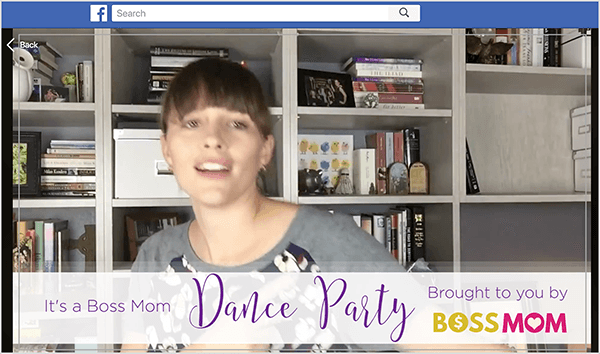
These milestone celebrations generate lots of engagement. When the group is about to hit a milestone, she asks what songs members want her to play, and then members vote on the song they’ll dance to. The celebration itself is a great way to get people super-pumped about what you’re doing.
I ask how often Dana recommends doing celebration posts. Dana says if you have a group of positive, action-hungry people, you could celebrate all the time. During the first year of Dana’s group, she featured a Boss Mom of the Week to celebrate somebody. For each Boss Mom, she asked them questions, wrote a post about them, and celebrated them in the Facebook group.
However, you don’t want to do a celebration every day because the tactic can lose its usefulness and impact. The size and activity of your group can help you gauge how frequently to celebrate. Because Dana’s group is large and has hundreds of posts per day, posts can get lost in a short period of time. So her group can celebrate every week without overdoing it.
Movement Principles: When your group is built around a movement, you can use that to ask questions about your principles or things the group cares about. For this tactic to work, make sure your group has a clear understanding of the culture. Without rules in place, be wary of this tactic. For instance, the Boss Mom group doesn’t allow political or religious posts because they can be controversial.

For Dana, Boss Moms can talk about business and parenting. People who want to discuss other topics can find other groups for that. In fact, she’s done posts where people can share their groups, whether they’re political, religious, or focused on topics like pet ownership or pregnancy. This thread gives people an outlet. Also, her clarity about what’s allowed helps keep people happy.
In a post about movement principles, Dana might say, “I have this really strong belief that I am a woman and a mom and an entrepreneur. I should be able to wear a collared shirt on top with yoga pants and a pair of heels, so I can be all three at once. Who is with me? Will you post a picture of what you’re wearing today?”
With these posts, Dana wants to voice what other people are thinking but might not say. The idea is to give other members permission to share what they’re thinking, what they believe, and what they care about within the mom and entrepreneur space. Then the group can band together and help that person feel not so alone.

Dana’s second book, Confessions of a Boss Mom, shares stories of women in all different situations. Like her movement posts in the Facebook group, her goal is to show that whatever you’re going through, you’re not the only one in the universe going through it. These statements help group members feel connected and loyal to the group, and want to share the group with others.
Reinvigorate Posts: This tactic is about how you respond to people who engage with your posts in a Facebook group. Instead of liking and commenting on people’s responses all at once, Dana recommends going slow and easy. Like one post, let it sit for a while, like another, and let it sit for a while. Every time you engage, the post pops back up to the top of the group and new people see it.
With this approach, you can keep one post alive for a week or more. After the post has been at the top for long enough, it starts trending and gains momentum organically so that even more people see it. The more people who comment on the post, the more the Facebook algorithm shows the post in people’s news feeds.
Also, if you make a post in a Facebook group and no one comments on it, try editing the post. Tweaking the post can help make it successful. After you edit the post, you can ask a friend to comment on it so that more people see it. Sometimes, Dana edits a post two or three times before people start to engage. Don’t let your post die without a little bit of effort.
Priming Posts: These posts teach the Facebook algorithm that your posts are interesting. Whether you’re posting to a group or a page, in the 6 weeks before you launch something, you want to prime the algorithm by asking questions that have nothing to do with your launch, but which people feel compelled to answer.
For this tactic, you can try celebration posts or just little things people want to talk about. You might say, “I was in the supermarket and the person in front of me whipped out 40 coupons. Everybody post a GIF for how you would feel if that was happening to you right now. Here is mine.”
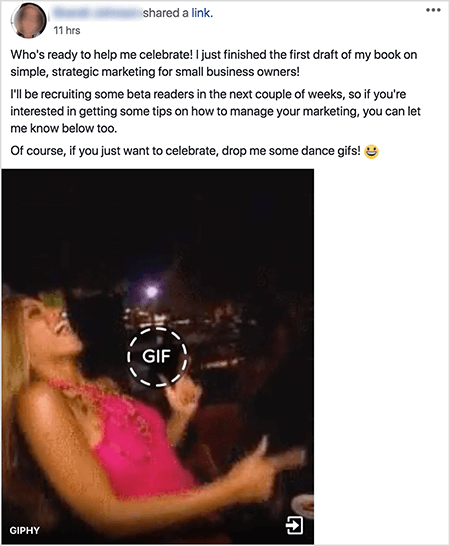
You don’t want to waste that priming of the algorithm on important blog posts that will encourage people to buy your stuff or opt into your offer. When you do that, nobody sees the important blog post or opts in.
To prime the algorithm successfully, start 6 weeks before you want to post the important item and post at least once a week. In other words, make six posts about whether people like cats or dogs, where your audience can’t help but comment and engage. Then when you post about your opt-in, program, or sale, Facebook thinks you’re popular and shows your post to more people organically.
Listen to the show to hear how a conversation about choosing carpet became the most engaging video in the first season of The Journey.
Discovery of the Week
SparkScore is an online tool for analyzing your Twitter engagement.
This tool, developed by Rand Fishkin of Moz, looks at followers, retweets, likes, and lists to measure your Twitter influence. A social media manager can check this report on the same day every week to get a snapshot of Twitter engagement and see whether it’s up or down.
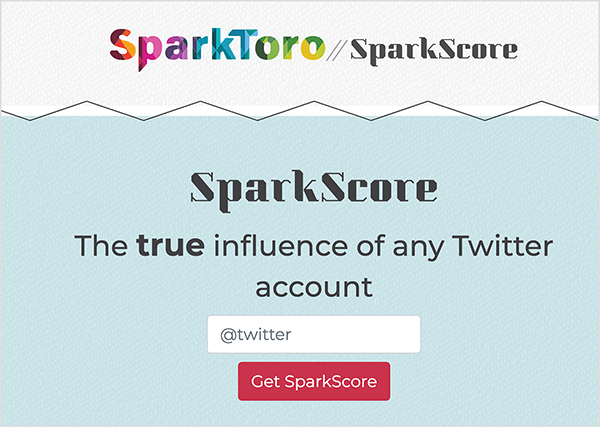
Unlike tools such as Klout, SparkScore aims to be transparent about how it analyzes your Twitter account and offers reports on the metrics it examines. To use SparkScore, you have to connect it to your Twitter account. You can check up to 25 accounts per day.
SparkScore is free to use and you access it via the web.
Listen to the show to learn more and let us know how SparkScore works for you.
Key takeaways from this episode:
What do you think? What are your thoughts on Facebook group engagement? Please share your comments below.
